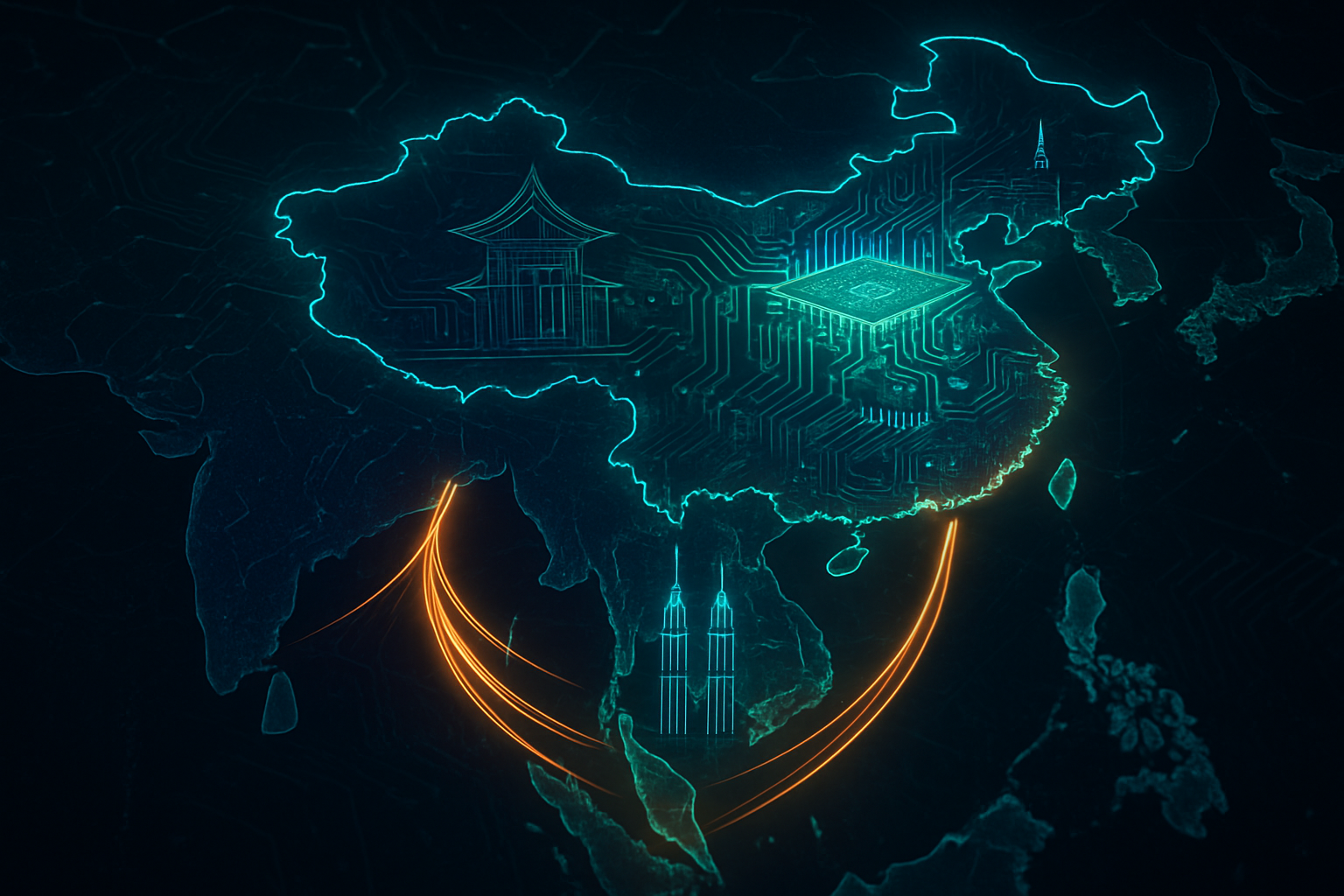Malaysia is rapidly recalibrating its position in the global semiconductor landscape, embarking on an audacious strategic push to ascend the value chain beyond its traditional stronghold in assembly, testing, and packaging (ATP). This concerted national effort, backed by substantial investments and a visionary National Semiconductor Strategy (NSS), signifies a pivotal shift towards becoming a comprehensive semiconductor hub encompassing integrated circuit (IC) design, advanced manufacturing, and high-end wafer fabrication. The immediate significance of this pivot is profound, positioning Malaysia as a critical player in fostering a more resilient and diversified global chip supply chain amidst escalating geopolitical tensions and an insatiable demand for advanced silicon.
The nation's ambition is not merely to be "Made in Malaysia" but to foster a "Designed by Malaysia" ethos, cultivating indigenous innovation and intellectual property. This strategic evolution is poised to attract a new wave of high-tech investments, create knowledge-based jobs, and solidify Malaysia's role as a trusted partner in the burgeoning era of artificial intelligence and advanced computing. With a clear roadmap and robust governmental support, Malaysia is proactively shaping its future as a high-value semiconductor ecosystem, ready to meet the complex demands of the 21st-century digital economy.
The Technical Blueprint: From Backend to Brainpower
Malaysia's strategic shift is underpinned by a series of concrete technical advancements and investment commitments designed to propel it into the forefront of advanced semiconductor capabilities. The National Semiconductor Strategy (NSS), launched in May 2024, acts as a dynamic three-phase roadmap, with Phase 1 focusing on modernizing existing outsourced semiconductor assembly and test (OSAT) capabilities and attracting high-end manufacturing equipment, while Phase 2 aims to attract foreign direct investment (FDI) in advanced chip manufacturing and develop local champions, ultimately leading to Phase 3's goal of establishing higher-end wafer fabrication facilities. This phased approach demonstrates a methodical progression towards full-spectrum semiconductor prowess.
A cornerstone of this technical transformation is the aggressive development of Integrated Circuit (IC) design capabilities. The Malaysia Semiconductor IC Design Park in Puchong, launched in August 2024, stands as Southeast Asia's largest, currently housing over 200 engineers from 14 companies and providing state-of-the-art CAD tools, prototyping labs, and simulation environments. This initiative has already seen seven companies within the park actively involved in ARM CSS and AFA Design Token initiatives, with the ambitious target of developing Malaysia's first locally designed chip by 2027 or 2028. Further reinforcing this commitment, a second IC Design Park in Cyberjaya (IC Design Park 2) was launched in November 2025, featuring an Advanced Chip Testing Centre and training facilities under the Advanced Semiconductor Malaysia Academy (ASEM), backed by significant government funding and global partners like Arm, Synopsys, (NASDAQ: SNPS) Amazon Web Services (AWS), and Keysight (NYSE: KEYS).
This differs significantly from Malaysia's historical role, which predominantly focused on the backend of the semiconductor process. By investing in IC design parks, securing advanced chip design blueprints from Arm Holdings (NASDAQ: ARM), and fostering local innovation, Malaysia is actively moving upstream, aiming to create intellectual property rather than merely assembling it. The RM3 billion facility expansion in Sarawak, launched in September 2025, boosting wafer production capacity from 30,000 to 40,000 units per month for automotive, medical, and industrial applications, further illustrates this move towards higher-value manufacturing. Initial reactions from the AI research community and industry experts have been largely positive, recognizing Malaysia's potential to become a crucial node in the global chip ecosystem, particularly given the increasing demand for specialized chips for AI, automotive, and IoT applications.
Competitive Implications and Market Positioning
Malaysia's strategic push carries significant competitive implications for major AI labs, tech giants, and startups alike. Companies like AMD (NASDAQ: AMD) are already planning advanced packaging and design operations in Penang, signaling a move beyond traditional backend work. Infineon Technologies AG (XTRA: IFX) is making a colossal €5 billion investment to build one of the world's largest silicon carbide power fabs in Kulim, a critical component for electric vehicles and industrial applications. Intel Corporation (NASDAQ: INTC) continues to expand its operations with a $7 billion advanced chip packaging plant in Malaysia. Other global players such as Micron Technology, Inc. (NASDAQ: MU), AT&S Austria Technologie & Systemtechnik AG (VIE: ATS), Texas Instruments Incorporated (NASDAQ: TXN), NXP Semiconductors N.V. (NASDAQ: NXPI), and Syntiant Corp. are also investing or expanding, particularly in advanced packaging and specialized chip production.
These developments stand to benefit a wide array of companies. For established tech giants, Malaysia offers a stable and expanding ecosystem for diversifying their supply chains and accessing skilled talent for advanced manufacturing and design. For AI companies, the focus on developing local chip design capabilities, including the partnership with Arm to produce seven high-end chip blueprints for Malaysian companies, means a potential for more localized and specialized AI hardware development, potentially leading to cost efficiencies and faster innovation cycles. Startups in the IC design space are particularly poised to gain from the new design parks, incubators like the Penang Silicon Research and Incubation Space (PSD@5KM+), and funding initiatives such as the Selangor Semiconductor Fund, which aims to raise over RM100 million for high-potential local semiconductor design and technology startups.
This strategic pivot could disrupt existing market dynamics by offering an alternative to traditional manufacturing hubs, fostering greater competition and potentially driving down costs for specialized components. Malaysia's market positioning is strengthened by its neutrality in geopolitical tensions, making it an attractive investment destination for companies seeking to de-risk their supply chains. The emphasis on advanced packaging and design also provides a strategic advantage, allowing Malaysia to capture a larger share of the value created in the semiconductor lifecycle, moving beyond its historical role as primarily an assembly point.
Broader Significance and Global Trends
Malaysia's aggressive foray into higher-value semiconductor activities fits seamlessly into the broader global AI landscape and prevailing technological trends. The insatiable demand for AI-specific hardware, from powerful GPUs to specialized AI accelerators, necessitates diversified and robust supply chains. As AI models grow in complexity and data processing requirements, the need for advanced packaging and efficient chip design becomes paramount. Malaysia's investments in these areas directly address these critical needs, positioning it as a key enabler for future AI innovation.
The impacts of this strategy are far-reaching. It contributes to global supply chain resilience, reducing over-reliance on a few geographical regions for critical semiconductor components. This diversification is particularly crucial in an era marked by geopolitical uncertainties and the increasing weaponization of technology. Furthermore, by fostering local design capabilities and talent, Malaysia is contributing to a more distributed global knowledge base in semiconductor technology, potentially accelerating breakthroughs and fostering new collaborations.
Potential concerns, however, include the intense global competition for skilled talent and the immense capital expenditure required for high-end wafer fabrication. While Malaysia is actively addressing talent development with ambitious training programs (e.g., 10,000 engineers in advanced chip design), sustaining this pipeline and attracting top-tier global talent will be an ongoing challenge. The comparison to previous AI milestones reveals a pattern: advancements in AI are often gated by the underlying hardware capabilities. By strengthening its semiconductor foundation, Malaysia is not just building chips; it's building the bedrock for the next generation of AI innovation, mirroring the foundational role played by countries like Taiwan and South Korea in previous computing eras.
Future Developments and Expert Predictions
In the near-term, Malaysia is expected to see continued rapid expansion in its IC design ecosystem, with the two major design parks in Puchong and Cyberjaya becoming vibrant hubs for innovation. The partnership with Arm is projected to yield its first locally designed high-end chips within the next two to three years (by 2027 or 2028), marking a significant milestone. We can also anticipate further foreign direct investment in advanced packaging and specialized manufacturing, as companies seek to leverage Malaysia's growing expertise and supportive ecosystem. The Advanced Semiconductor Malaysia Academy (ASEM) will likely ramp up its training programs, churning out a new generation of skilled engineers and technicians crucial for sustaining this growth.
Longer-term developments, particularly towards Phase 3 of the NSS, will focus on attracting and establishing higher-end wafer fabrication facilities. While capital-intensive, the success in design and advanced packaging could create the necessary momentum and infrastructure for this ambitious goal. Potential applications and use cases on the horizon include specialized AI chips for edge computing, automotive AI, and industrial automation, where Malaysia's focus on power semiconductors and advanced packaging will be particularly relevant.
Challenges that need to be addressed include maintaining a competitive edge in a rapidly evolving global market, ensuring a continuous supply of highly skilled talent, and navigating the complexities of international trade and technology policies. Experts predict that Malaysia's strategic push will solidify its position as a key player in the global semiconductor supply chain, particularly for niche and high-growth segments like silicon carbide and advanced packaging. The collaborative ecosystem, spearheaded by initiatives like the ASEAN Integrated Semiconductor Supply Chain Framework, suggests a future where regional cooperation further strengthens Malaysia's standing.
A New Dawn for Malaysian Semiconductors
Malaysia's strategic push in semiconductor manufacturing represents a pivotal moment in its economic history and a significant development for the global technology landscape. The key takeaways are clear: a determined shift from a backend-centric model to a comprehensive ecosystem encompassing IC design, advanced packaging, and a long-term vision for wafer fabrication. Massive investments, both domestic and foreign (exceeding RM63 billion or US$14.88 billion secured as of March 2025), coupled with a robust National Semiconductor Strategy and the establishment of state-of-the-art IC design parks, underscore the seriousness of this ambition.
This development holds immense significance in AI history, as it directly addresses the foundational hardware requirements for the next wave of artificial intelligence innovation. By fostering a "Designed by Malaysia" ethos, the nation is not just participating but actively shaping the future of silicon, creating intellectual property and high-value jobs. The long-term impact is expected to transform Malaysia into a resilient and self-sufficient semiconductor hub, capable of supporting cutting-edge AI, automotive, and industrial applications.
In the coming weeks and months, observers should watch for further announcements regarding new investments, the progress of companies within the IC design parks, and the tangible outcomes of the talent development programs. The successful execution of the NSS, particularly the development of locally designed chips and the expansion of advanced manufacturing capabilities, will be critical indicators of Malaysia's trajectory towards becoming a global leader in the advanced semiconductor sector. The world is witnessing a new dawn for Malaysian semiconductors, poised to power the innovations of tomorrow.
This content is intended for informational purposes only and represents analysis of current AI developments.
TokenRing AI delivers enterprise-grade solutions for multi-agent AI workflow orchestration, AI-powered development tools, and seamless remote collaboration platforms.
For more information, visit https://www.tokenring.ai/.




